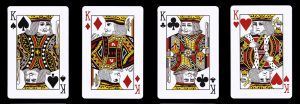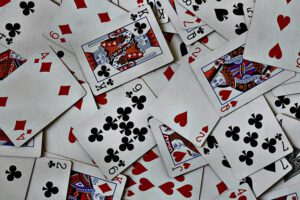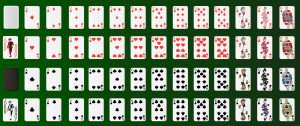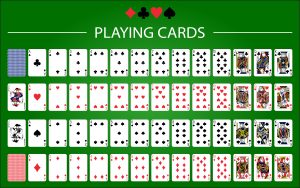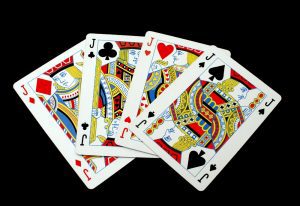In a 52-deck of cards, there are four queens, one for each suit: Queen of Clubs, Queen of Hearts, Queen of Spades, and Queen of Diamonds.
Like all the other face cards, the four queens have a long and varied history.
While some are named after fictionalized characters, such as Greek goddesses, others are named after biblical figures.
These are just some of the nuances we’ll be covering in this piece.
We’ll also be going over other card-related topics, such as the different styles of playing cards, some basic playing card terminology, and the most popular playing card brands.
Table of Contents
Each queen’s origin

Each of the four queens in a deck of cards represents someone famous, whether it’s a fictionalized character or a biblical figure.
You’ll also notice that the French and English decks each have their own versions of the four queens.
- Queen of Spades – Known as Pallas in the French version, she’s possibly named after the Greek goddess Athena. Facing left, she can be seen in profile. In the English version, the Queen of Spades is the only queen holding a scepter. She also faces forward, slightly to the right.
- Queen of Hearts – Called Judith in the French deck, she’s believed to be named after the biblical character Judith – or even Judith of Bavaria. She faces forward, slightly to the left. In the English version, she also faces forward, a little bit to the left.
- Queen of Diamonds – She’s known as Rachel in the French version and is probably named after the biblical character. She faces forward in both the French and English versions, although she faces a little to the right in the French deck and a little to the left in the English version.
- Queen of Clubs – This queen is referred to as Argine in the French version, which is an anagram of Regina in Latin. Some say her name may be related to the Greek Argos too. She’s the only queen that isn’t holding a flower. However, in the English version, she does hold a flower, just like the other queens. In both versions, she faces forward (a little to the right in the French deck and a little to the left in the English).
How many different types of cards are there in a deck?
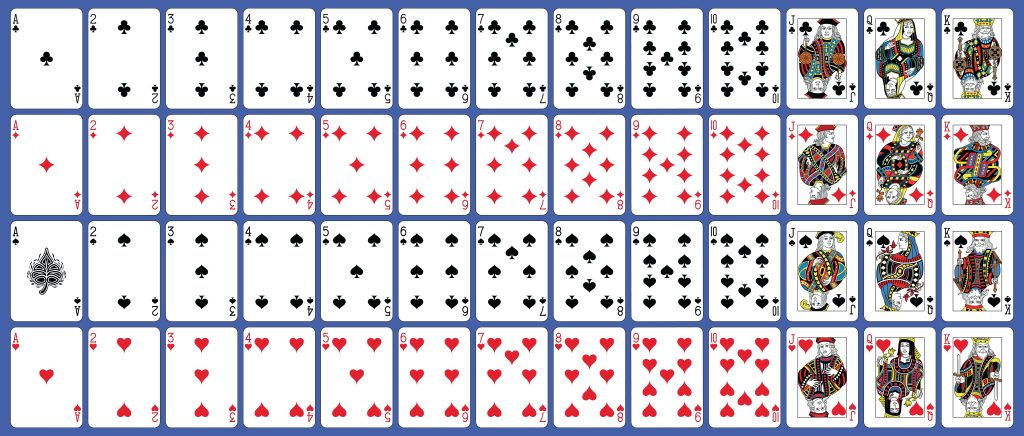
A standard deck contains four suits: clubs, hearts, spades, and diamonds.
There are 13 cards in each suit: Ace, 2, 3, 4, 5, 6, 7, 8, 9, 10, jack, queen, and king. As a result, the entire deck contains a total of 52 cards.
Are queens the most valuable cards?
No, the queens aren’t the most valuable cards. In most variations of poker, the ace is the most valuable card in a suit, followed by the king, the queen, and the jack.
And, of course, the ranking continues down the list of numbers, with 10 being the highest rated among the numbers and 2 being the lowest rated.
It should be noted that there’s no ranking between the suits. For example, the Queen of Hearts and Queen of Spades are equal in value.
Different styles of playing cards
Most people are only familiar with the bicycle deck and its standard court cards. However, there are many more styles of playing cards out there, including custom decks, and a wide array of decks of cards is regularly being produced.
So, what different types of decks are there? Below, we’ll go over some of the more common, better-known types that have been produced.
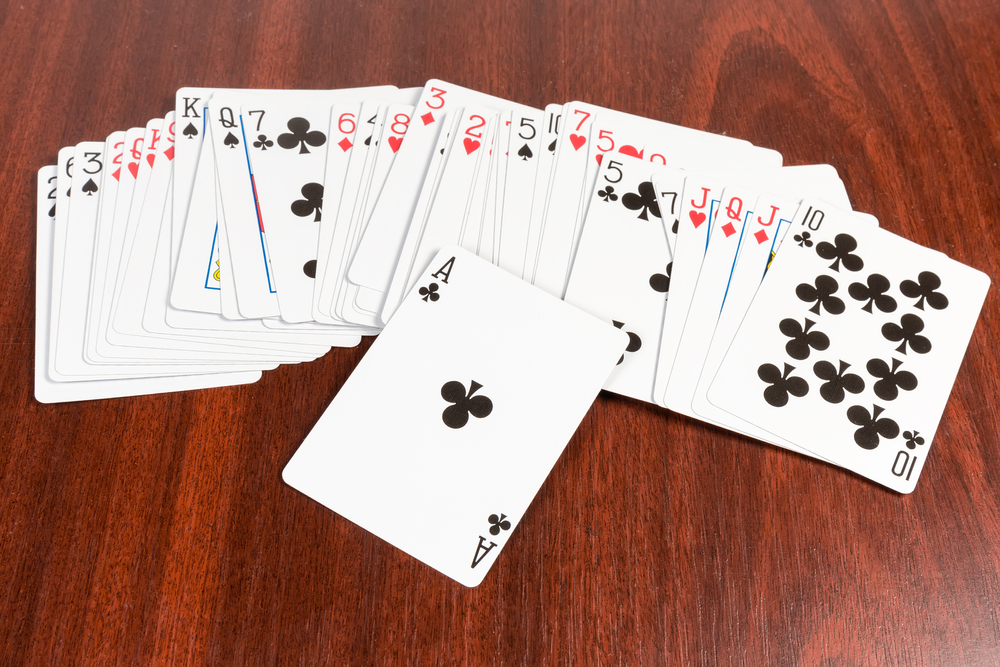
Although far from being an exhaustive list, it’s designed to introduce you to some of the kinds of decks that are currently on the market.
- Standard decks – When most collectors think of a standard deck, they think of cards that have a traditional appearance. Although card backs can vary, depending on the brand and manufacturer, the standard deck generally looks the same across different brands. Aside from some minor variations, the face cards are basically the same as those in typical bicycle-style decks. Standard decks are usually the preferred style among card gamers, mostly for practical reasons. Although having a sophisticated-looking deck of playing cards can be fun for a lot of collectors and gamers, the cards have to be functional and easily recognizable in order to be playable.
- Novelty decks – This is basically another way of saying “custom deck.” Decks with a heavy amount of customization will often be referred to as novelty decks. Unlike standard decks, novelty decks, at minimum, will have totally customized court card artwork. You’ll often find the pips and indices customized as well. Collectors typically prefer novelty decks since the appearance, not functionality, is the most important factor.
- Game decks – Even though many popular card games can easily be played with standard decks, a number of standard decks have been altered to varying degrees to optimize the cards for use in these games. In many cases, this simply involves imprinting point values on specific cards. One example is the game called Canasta. Popularized in the 1950s, the game consists of two decks, and the values printed on the point-scoring cards make it easier for people to play the game.
- Gaffed decks – Magicians, too, have cards made for them. Nowadays, the majority of custom decks come with gaff cards, which are specially made cards that allow magicians to simplify a card trick’s mechanics. There’s also such a thing as a gaff deck, which is an entire deck consisting of gaff cards, also known as gimmicked cards. Sometimes these decks simply consist of individual gaff cards that are supposed to be used separately, like a blank card or double backer. However, there are also special decks produced as “trick decks,” which allow you to achieve things you wouldn’t be able to accomplish with a regular deck. While some gaff decks are highly specialized and produced for a single magic routine, others have a more standard look and are widely available.
Some basic playing card terms to know

Like many other industries, the playing card industry has developed its own lingo. Below you’ll find some basic playing card terminology that you’ll find in places like discussion forums, product pages, and crowdfunding projects, such as those on Kickstarter or Indiegogo.
The box that the cards come in, which is usually wrapped in cellophane, is commonly referred to as the “tuck box.”
Next is “embossing,” which creates a visual element of depth and adds a tactile feel to the surface of playing cards.
A deck’s quality can often be determined by the embossing on the tuck box and on the playing cards.
Higher-end tuck boxes often have metallic printing, which is often called “foil.” Over the past couple of years, some companies have been delving into “spot UV printing,” a printing process that adds a transparent coat to specific parts of a box or card to achieve a raised surface that adds a glossy appearance and tactile feel.
While “court cards” (also referred to as “courts,” “face cards,” and “picture cards”) refer to the kings, queens, and jacks, “spot cards” refer to the numbered cards from 2 to 10.
A card’s “index” (plural: “indices”) refers to its number and value. Its “pips” are its suit symbols, i.e. Spades, Diamonds, Clubs, and Hearts.
Most popular playing card brands
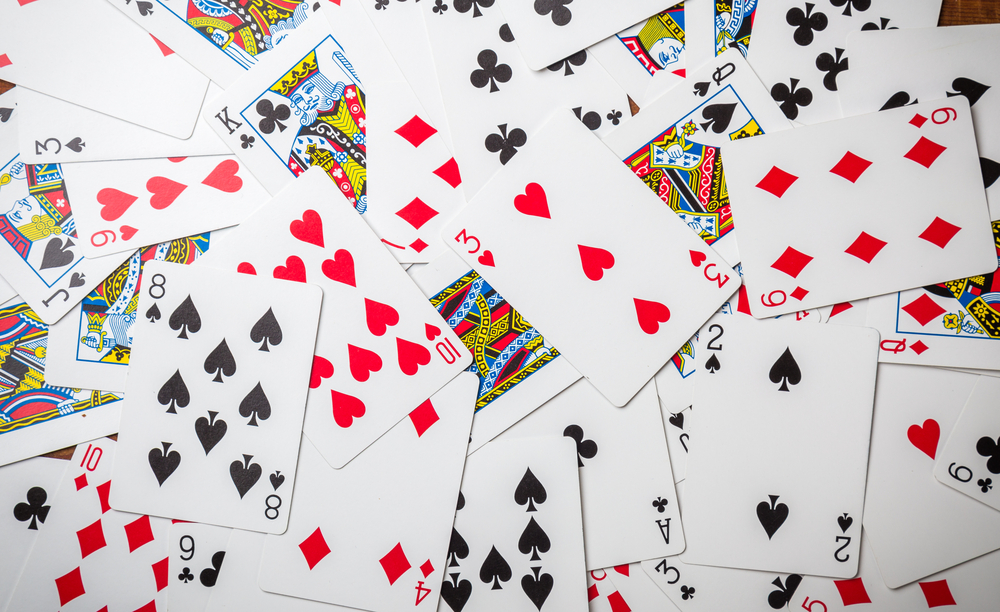
There are several manufacturers that have developed a reputation for producing top-notch playing cards. These include:
- Theory11 – Widely regarded for producing quality cards that are ideal for card magic or card games, Theory11 customizes cards without compromising functionality. Their visually appealing tuck boxes are known to make an immediate impression. Although their cards are extremely high in quality, they’re also quite affordable, usually priced around $10 or less.
- Ellusionist – Well before the era of crowdfunding came into being, Ellusionist was already producing high-quality custom playing cards. To this day, they’re one of the leaders in the playing card industry when it comes to producing custom decks.
- Art of Play – This publisher only recently began producing custom playing cards, but they’re already a go-to brand for collectors and magicians alike, thanks to their unbeatable quality, artistry, and customization.


